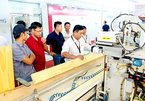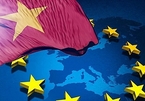 |
| Compared with rivals, Vietnam enjoys a big advantage in shrimp exports to the EU - PHOTO: LE HOANG VU |
However, what the Vietnamese side needs to do is to standardize the value chain in the country.
Along with textiles and garments, footwear, machinery and phone components, agro-products in the Mekong Delta are affording a big opportunity when tariffs are eliminated immediately or reduced gradually after the EVFTA takes effect. According to the Ministry of Industry and Trade’s Import-Export Department, the EU market has a huge demand for imports, with about US$2.338 trillion in 2018. Vietnam’s exports made up only some 2% share of this market.
The department said the EU is the third largest market for Vietnam’s fisheries after the United States and Japan, with US$1.25 billion, accounting for 15% of Vietnam’s fisheries exports in 2019. For shrimps, the flagship export of the Mekong Delta, the tariff for frozen tiger prawns under the Generalized System of Preferences (GSP) will be cut from 4.2% to zero when the EVFTA takes effect. The tax for frozen white shrimps will be reduced gradually to zero after five years.
Compared with rivals, Vietnam enjoys a big advantage in shrimp exports to the EU. Thailand, which does not enjoy the GSP and has no FTA with the EU, is subject to a basic tariff of 12%. India and Indonesia, which have no FTA with the EU, have to pay a tax of 4.2% under the GSP. Ecuador, like Thailand, is subject to the same tax of 12%.
Ho Quoc Luc, chairman of Sao Ta Foods Joint-stock Company (FMC), said the key market for Vietnam’s shrimps after the EVFTA takes effect (August 1, 2020) is the EU. “The shrimp industry will definitely get better growth when the tariff for shrimps is reduced drastically, down to zero for some shrimp products, when the EVFTA takes effect.”
For tuna, the EU will eliminate tariffs for fresh and frozen tuna, except frozen minced and fillet tuna (HS code 030487), over three years. The tariff for steamed minced and fillet tuna (materials to produce canned tuna), currently at 24%, will be scrapped over seven years. Canned tuna products of various kinds will enjoy tariff exemption for an annual quota of 11,500 tons, according to the Import-Export Department.
Under the EVFTA, the tariff for pangasius fish will be cut from the current 5.5% to zero in the third year after the agreement takes effect.
Some processed seafood products subject to a basic tariff of 20%, such as oysters, clams, squids, octopuses and abalone, will enjoy a zero tax when the agreement takes effect. The tariff for frozen squids and octopuses will be cut immediately from 6-8% to zero, for surimi from 14.2% to zero, and other frozen marine fish from 7.5% to zero.
For vegetables and fruit and processed products from vegetables and fruit, the tariff for 94% of the total of 547 tariff lines will be scrapped immediately. Among those vegetables and fruit are a number of products which Vietnam as well as the Mekong Delta have strong advantages, such as longans, rambutans, dragon fruit, pineapples, melons and lychees.
Most of the tariff lines which the EU has pledged to eliminate are those with an average tax of 10%, and some with a tax of over 20%. The tax cut will give Vietnamese vegetables and fruit a strong advantage in prices over those of rivals.
For rice, the EU grants Vietnam a tax exemption quota of 80,000 tons per year, including 30,000 tons of husked rice, 20,000 tons of unhusked rice and 30,000 tons of frangrant rice. In particular, broken rice will enjoy a zero tax after five years the agreement takes effect. For products from rice, the tax will drop to zero after three to five years.
Standardization crucial
To seize the opportunity from the EVFTA, the Import-Export Department said it’s necessary to restructure agriculture. The quality of export agro products must be standardized to meet criteria for food hygiene and safety. In addition, the post-harvest preservation technology for fresh vegetables and fruit shoud be applied.
Economic expert Tran Huu Hiep told the Saigon Times that agriculture in the Mekong Delta has made progress, especially in the development of value chains. “Agriculture has obviously received interest in investment and development of material growing areas from some big enterprises,” Hiep said.
However, Hiep noted that it was the progress over the past. For the present, especially with the challenges when Vietnam enters a big market with increasingly stricter requirements under the EVFTA, there is still room for improvement.
First, export products must have perfect quality as per standards and meet the requirement for origin traceability, that is the product value chain must be really connected and accountable for responsibility. Second, participants in the value chain must have close connection, not separation like the situation in the past. “Take for an example,” Hiep said, “agro-product sales contracts in the past might be affected in prices when buyers and sellers broke their promises and turned agaisnt each other.” He noted that it was an extremely loose connection, a weakness that must be rectified to standardize the value chain and make quality products to meet requirements under the EVFTA.
Nguyen Minh Toai, director of the Department of Industry and Trade of Can Tho City, said with the EVFTA, enterprises will have to trace the origin by themselves. If the traceability is executed well, their exports to the EU will be very favorable. “However, if only one enterprise performs wrongly, the entire export industry may be banned. So, there must be a roadmap and control of the authorities to prevent the case that one poor performer may tarnish the national reputation,” Toai noted.
For aquaculture products, besides origin traceability to meet the requirements under the EVFTA, enterprises must improve product quality and leave no antibiotics. “The EVFTA is an advantage for Vietnam, opening a large market for the country. But to make full use of the advantage, enterprises must meet the requirements,” he said.
Pham Dinh Vu, chief office manager of the Vietnam Chamber of Commerce and Industry (VCCI), thought that the EVFTA is a “highway” to connect Vietnam and the EU market. However, to join the highway, apart from the removal of institutional barriers, enterprises must upgrade themselves to meet the international commitments and regulations. “Drivers on the highway must meet standards, especially legal regulations, for smooth traffic,” Vu said, suggesting that enterprises should upgrade their management capacity. SGT
Trung Chanh

Many businesses indifferent to EVFTA
EVFTA is expected to pave the way for Vietnam’s enterprises to exploit the EU market and its 500 million consumers and GDP of $18 trillion.

Can Vietnam’s enterprises take full advantage of EVFTA?
Deputy Minister of Industry and Trade Tran Quoc Khanh, speaking at a recent conference, expressed his concern about the indifference shown by many Vietnam’s enterprises to EVFTA (EU-Vietnam Free Trade Agreement).